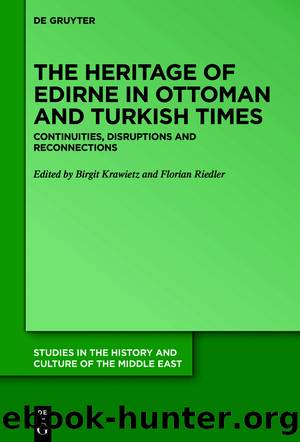The Heritage of Edirne in Ottoman and Turkish Times by Birgit Krawietz Florian Riedler

Author:Birgit Krawietz, Florian Riedler
Language: eng
Format: epub
Publisher: De Gruyter
Published: 2019-12-16T12:58:05.471000+00:00
Part IV:
Crossroads Edirne
The Formation of the First Ottoman âMother of Israelâ in Edirne
Aziz Nazmi Åakir
The first âmother of Israelâ was Deborah in the biblical âBook of Judgesâ (5:7), who used this expression for herself to describe her role in the rebellion against the Canaanite king Jabin, who oppressed the Israelites.1 Nearly three millennia later, sons and daughters of Israel fleeing from Western Europe used the same metaphor for a non-Jewish city they had found refuge in, whose rulers felt self-assured enough to remove its walls and use their material for public buildings. Most historians of the Ottoman Empire will recognize the city of Selanik, present day Thessaloniki, in this description. For nearly three centuries (16thâ18th), its Sephardic Jewish community amounted to more than half the cityâs total population, and in fact they nicknamed it la madre de Israel (the mother of Israel).2
Without denying Selanikâs importance, in this article I will argue that it was not the first, but in fact the second Ottoman âmother of Israel,â after Edirne. The first mention of this honorary title in connection with Edirne we know of was not until the middle of the 17th century, and it was in Hebrew.3 At least for now, in the archival and secondary sources there is no trace of an Ottoman equivalent of this term, which seems logical, considering that the expression bears an emotional rather than an administrative connotation. Despite this late mention, I will demonstrate below that, already a century before Jews arrived in Selanik, the then Ottoman capital played a very similar role to the one Selanik would later. The following chapter traces the paths of the first Jewish emigrants heading from various parts of Europe toward the newly established second Ottoman capital Edirne, the formation of Jewish communities there, and their share in the social and cultural milieu of the city. The main sources used are Ottoman tax registers from three separate censuses held during the 16th century, textual descriptions of the city found in a number of travelogues, and monographs and articles related to the topics discussed.
Download
This site does not store any files on its server. We only index and link to content provided by other sites. Please contact the content providers to delete copyright contents if any and email us, we'll remove relevant links or contents immediately.
Spell It Out by David Crystal(35849)
Life for Me Ain't Been No Crystal Stair by Susan Sheehan(35536)
Cecilia; Or, Memoirs of an Heiress — Volume 1 by Fanny Burney(32064)
Cecilia; Or, Memoirs of an Heiress — Volume 3 by Fanny Burney(31458)
Cecilia; Or, Memoirs of an Heiress — Volume 2 by Fanny Burney(31409)
The Great Music City by Andrea Baker(30784)
Professional Troublemaker by Luvvie Ajayi Jones(29422)
We're Going to Need More Wine by Gabrielle Union(18635)
Twilight of the Idols With the Antichrist and Ecce Homo by Friedrich Nietzsche(18303)
The Secret History by Donna Tartt(18168)
Cat's cradle by Kurt Vonnegut(14763)
All the Missing Girls by Megan Miranda(14748)
Pimp by Iceberg Slim(13781)
Bombshells: Glamour Girls of a Lifetime by Sullivan Steve(13687)
Fifty Shades Freed by E L James(12918)
Talking to Strangers by Malcolm Gladwell(12879)
Norse Mythology by Gaiman Neil(12836)
The Social Justice Warrior Handbook by Lisa De Pasquale(11956)
Underground: A Human History of the Worlds Beneath Our Feet by Will Hunt(11840)
